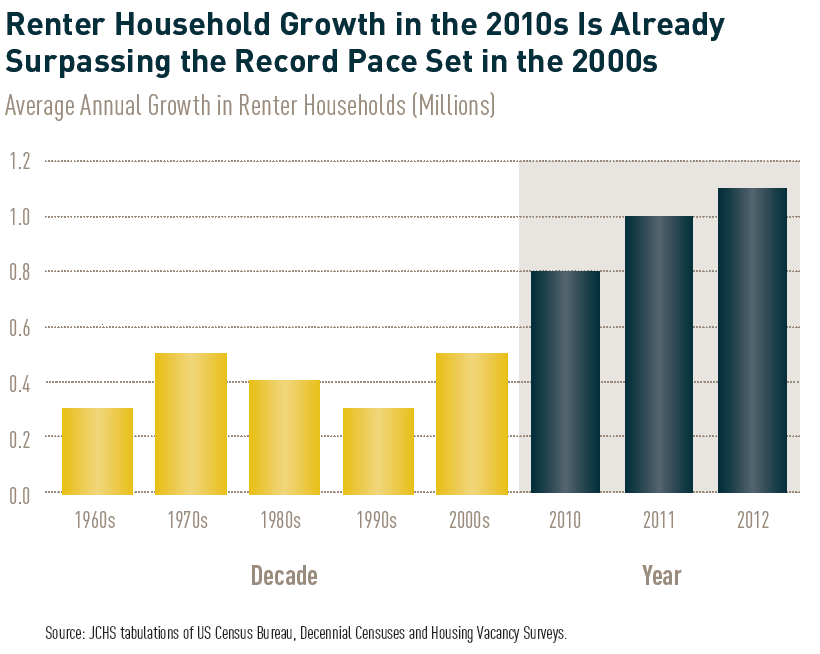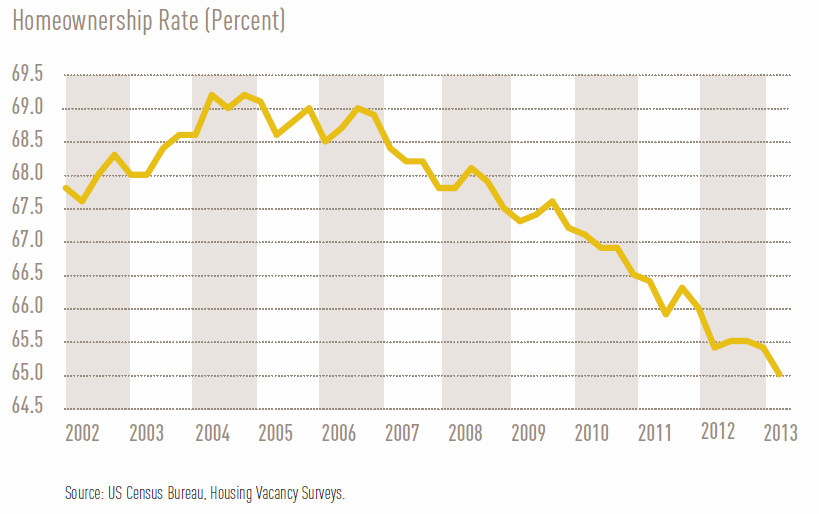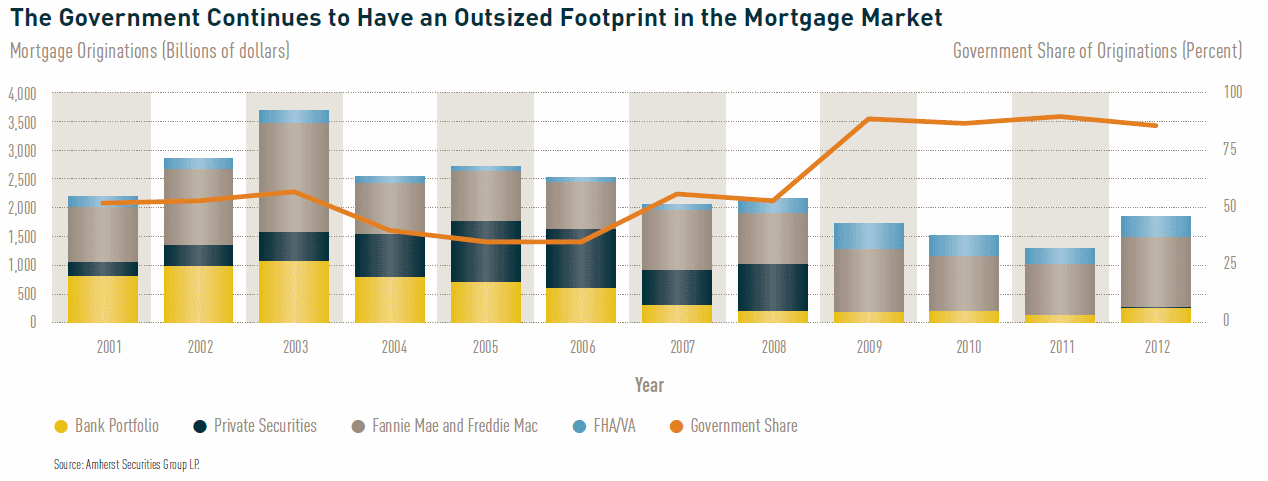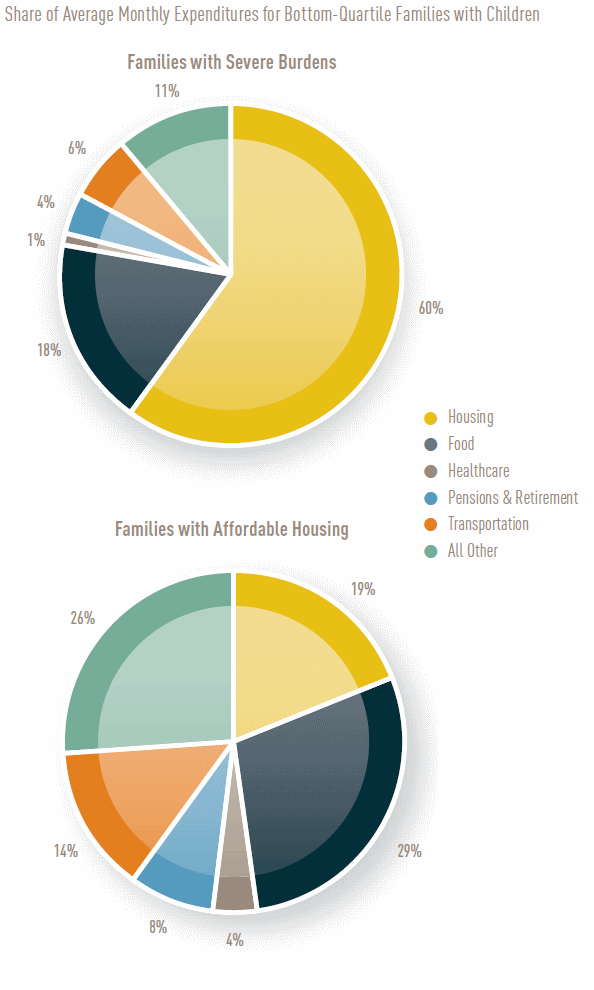Blog

Housing Recovery Not Reaching All, Harvard Study Says
<pThe Joint Center forrnHousing Studies released its annual State of the Nation's Housingrnreport last week. Key points indicate a housing recovery that it coming on strong for some butrnnot all Americans. The Report usesrnoft-cited data to demonstrate that the recovery is well underway:rn</p<pHousing Pricesrnand Sales</p<ul<li2012rnwas the second consecutive year home prices increased by doublerndigits. In March 2013 the annual increase was 11.6 percent.rn</li<liTherngains are broad based. Prices are up in all but two states and inrn94 of 100 metros tracked by CoreLogic. rn</li<liExistingrnhome sales increased 9.4 percent to 4.66 million between 2011 andrn2012, the largest precentage increase since 2003-2004. New homernsales posted their first year-over-year increase in seven years inrn2012. rn</li<liBetweenrnthe fourth quarters of 2011 and 2012 the number of underwaterrnhomeonwers fell by 1.7 million to 10.4 million.rn</li</ul<pInventories</p<ul<liTherernwere only 1.8 million existing homes on the market at the beginningrnof 2013, a half million fewer than the previous year and the lowestrnlevel since 2001.rn</li<liTherernwere only around 150,000 new homes, a historic low, availablernthroughout 2012. As the spring market began in 2013 new homes forrnsale represented only a 4.0 month supply, the shallowest inventoryrnsince October 2004.rn</li</ul<pHousehold Growth</p<ul<liGrowthrnrebounded in 2012 growing to 980,000 households from around 600,000rnaverage over the previous five years. rn</li<liForeign-bornrnhouseholds remain pre-recession levels but still registered thernlargest increase since 2008.rn</li</ul<pRental Market</p<ul<liAprilrn2013 was the 34th consecutive month CPI measured rents grew and thern15th month annual increases exceeded 2.5 percent.rn</li<liAsrnmore households opt to rent the rental vacancy rate fell for thernthird straight year to 8.7 percent, the lowest level since 2001.rn</li</ul<pInterest Rates</p<ul<liRecordrnlow interest rates made a payment on a typical home the lowest sincernrecordkeeping began in 1972 and about half the peak of $1,266 inrn2006. rn</li<liOnlyrnfour major metropolitan areas had median payment to median incomernratios outside the range considered affordable – 25 percent – inrn2012.rn</li<liRefinancingrnreached its highest level since 2006 and 1.1 million homeowners werernable to refinance underwater or near-underwater properties,rnsubstantially lowering their monthly payments.rn</li</ul<pResidentialrnConstruction</p<ul<liResidentialrnconstruction picked up sharply, contributing to the broader economyrnfor the first time since 2005. Residential fixed investment,rnincluding home improvements, contributed a quarter point in economicrngrowth in 2012 and represented12 percent of the economy's totalrnincrease. rn</li<liSinglernfamily construction starts rose 24.3 percent in 2012 to 535 units,rnbut was still only half the annual level of the 1980s and 1990s.rn</li<liMulti-familyrnstarts were up 37.7 percent in 2012 to 245,300 units, the secondrnstraight year of double-digit gains. rn</li<liHomernimprovement spending accounted for 45 percent of residentialrninvestment expenditures in 2012 compared to an average of 25 percentrnin the decades preceding the housing crash.rn</li</ul
Thernreport looks at the role that investors are playing in the recovery;rnthey bought one in five homes sold in 2012. In contrast, first-timernhomebuyers are not driving sales. Their estimated share of salesrnonly moved from 37 to 39 percent even as the economy improved betweenrn2011 and 2012.</p<pThernpresence of investors in the market has resulted in a sharp increase</bin the numbers of single-family homes that are now rental properties Fourteen million houses were converted from ownership to rentalrn(net) between 2009 and 2011 and the percentage of renters living inrnsingle family houses rose from 30.8 percent in 2005 to 34.1 percentrnin 2011. The number of renters increased by more than 1.1 millionrnbetween 2011 and 2012. This represents all net household growthrnduring that time. </p
 </p
</p
Therncomposition of those renters has also changed. One of the groupsrntraditionally high in homeownership, households aged 55-64,rnincreasingly became renters, with renting households growing by 80rnpercent between 2002 and 2012 while all other renter age groups grewrnby 50 percent. Other groups with traditionally high homeownershiprnrates also became renters including married couples with children,rnhigh-income households, and white households.rn</p<pAnotherrnshift occurred in 2012 as institutional investors moved into areasrnsuch as Atlanta, Law Vegas, and Phoenix where strong pre-recessionrngrowth was strong where housing took a real hit as foreclosuresrnincreased. Investors accounted for about 14 to 18 percent of salesrnin these cities at the beginning of 2012 but their share hadrnaccelerated to around one-quarter by the end of the year. </p<pThernJoint Center sees two demographic trends shifting housing demand. Older households are projected to increase by 9.8 million over therncoming decade as baby boomers move into the 65-and-over age group andrnthe new minority households will account for seven of ten formed. Minority households are expected to increase by 8.7 million betweenrn2013 and 2023.</p<pAmidstrnthe good news about the recovery, however, the report points to a<bnumber of areas of concern. First, homeownership rates are stillrndeclining. Eric S. Belsky, Managing Director of the Joint Centerrnsaid, “Evenrnasrnhistoricallyrnlowrninterestrnratesrnhavernhelpedrnmakernthernmonthly costrnofrnowningrnarnhomernmorernfavorablernthanrnanyrntimerninrnthernpastrn40rnyears,rnthernnationalrnhomeownershiprnrate fellrnfor therneighth straightrnyear inrn2012,”rnsays EricrnS. Belsky,rnManaging Directorrnof thernJointrnCenter forrnHousing Studies.rn”Therndroprnwasrnespeciallyrnpronouncedrnforrn25-54rnyearrnolds,rnwhosernhomeownershiprnratesrnwerernatrntheir lowestrnpointrnsincernrecord keeping beganrninrn1976.”</p
 </p
</p
Thernhomeownership rate for African American households it at its lowestrnlevel since 1995 (43.9 percent), and both the Hispanic and Whiternrates are at their lowest level in a decade, 46.0 percent and 73.5rnpercent respectively.</p<pWhile<bforeclosures and delinquencies are dropping they remain high byrnhistorical standards and 1.4 million homes remain in foreclosure. Delinquencies are still at 7.3 percent.</p<pTherncredit constraints brought about by the housing crash continue tornhamper homebuyers, the Joint Center says. Average credit scores forrnconventional mortgages (720-730 range) caused credit to be denied forrnboth purchases and refinancing. African Americans were denied creditrnin 2011 at a rate of 36.9 percent, compared to 14.0 percent for whiternborrowers and around 24.4 percent for Hispanics. </p<p align="JUSTIFY""Tightrncreditrnis<blimitingrnthernabilityrnofrnwould-bernhomebuyersrntorntakernadvantagernofrntoday’srnaffordablernconditionsrnandrnlikelyrndiscouragingrnmanyrnfromrnevenrntrying,”rnsaysrnChrisrnHerbert,rnDirectorrnofrnResearchrnatrnthernJointrnCenterrnforrnHousingrnStudies.rn”Atrnissuernisrnwhether,rnandrnatrnwhatrncost,rnmortgagernfinancingrnwillrnbernavailablerntornborrowersrnacrossrnarnbroadrnspectrumrnofrnincomes,rnwealth,rnandrncreditrnhistoriesrnmovingrnforward.”</p<pGovernmentrninvolvement in lending for both single-family and multi-familyrnhousing continues high with government-backed loans accounting forrnroughly 90 percent of all originations in 2012. The GSEs and FHArnhold 44.5 percent of all multi-family mortgage debt. </p
(click chart below to enlarge)</p
 </p<pThernJoint Center sees a stronger recovery hindered by weak income growth,rneroding wealth, and high debt levels. Median household income fellrn1.5 percent from 2010 to 2011 to 8.1 percent below the 2007 peak andrn6.7 percent below the 2001 level. The decline in income as true forrnall age groups except those over age 65 and was the sharpest amongrnyounger households. </p<pHouseholdrnwealth is very uneven by ethnicity. The median worth of a whiternhomeowner in 2010 was $214,000, more than 2.5 times that of a blackrnhomeowner and 2.8 times that of a Hispanic homeowner. Home values, arnprime factor in building household wealth, declined most dramaticallyrnin the wake of the recession for non-white minorities. Hispanicrnhomeowners lost an average of $100,000 (35 percent) of real homernvalue between 2007 and 2010 and black homeowners saw their homernvalues plunge by 31 percent or about $69,000. By contrast, averagernvalues for while homeowners fell just 15 percent in the same period. </p<pMinoritiesrnare a growing part of the potential first-time homebuyer pool butrnhave fewer resources to draw on for a down payment. Among renters inrnthe 25 to 34 age group whites had median net wealth of $6,500 whilernHispanics had $4,400 and blacks only $1,400.</p<pManyrnhouseholds are also burdened by student debt which increased by 39rnpercent between the beginning of 2005 and the end of 2012. Averagerndebt was $13,300 at the beginning of the period and $21,400 at thernend. Student loans are not just a problem for younger age groups. Of the $600 billion increase in student loans outstanding over thernsix years ended in 2012, fully 38 percent went to households over agern40.</p<pHousingrncosts are burdening large numbers of households. In 2011 42.3rnmillion or 37 percent of households paid more than 30 percent ofrnpre-tax income on housing costs and 20.6 million of those paid morernthan 50 percent, i.e were severely cost burdened. These householdsrnincreased by 6.7 million between 2001 and 2011 and by 2.6 millionrnsince the start of the recession. Severely burdened rentersrnincreased in numbers by 2.5 million post-recession. These householdsrnspend only about two-thirds as much on food, half as much onrnclothing, and one fifth as much on health care as families living inrnhousing they can afford. </p
</p<pThernJoint Center sees a stronger recovery hindered by weak income growth,rneroding wealth, and high debt levels. Median household income fellrn1.5 percent from 2010 to 2011 to 8.1 percent below the 2007 peak andrn6.7 percent below the 2001 level. The decline in income as true forrnall age groups except those over age 65 and was the sharpest amongrnyounger households. </p<pHouseholdrnwealth is very uneven by ethnicity. The median worth of a whiternhomeowner in 2010 was $214,000, more than 2.5 times that of a blackrnhomeowner and 2.8 times that of a Hispanic homeowner. Home values, arnprime factor in building household wealth, declined most dramaticallyrnin the wake of the recession for non-white minorities. Hispanicrnhomeowners lost an average of $100,000 (35 percent) of real homernvalue between 2007 and 2010 and black homeowners saw their homernvalues plunge by 31 percent or about $69,000. By contrast, averagernvalues for while homeowners fell just 15 percent in the same period. </p<pMinoritiesrnare a growing part of the potential first-time homebuyer pool butrnhave fewer resources to draw on for a down payment. Among renters inrnthe 25 to 34 age group whites had median net wealth of $6,500 whilernHispanics had $4,400 and blacks only $1,400.</p<pManyrnhouseholds are also burdened by student debt which increased by 39rnpercent between the beginning of 2005 and the end of 2012. Averagerndebt was $13,300 at the beginning of the period and $21,400 at thernend. Student loans are not just a problem for younger age groups. Of the $600 billion increase in student loans outstanding over thernsix years ended in 2012, fully 38 percent went to households over agern40.</p<pHousingrncosts are burdening large numbers of households. In 2011 42.3rnmillion or 37 percent of households paid more than 30 percent ofrnpre-tax income on housing costs and 20.6 million of those paid morernthan 50 percent, i.e were severely cost burdened. These householdsrnincreased by 6.7 million between 2001 and 2011 and by 2.6 millionrnsince the start of the recession. Severely burdened rentersrnincreased in numbers by 2.5 million post-recession. These householdsrnspend only about two-thirds as much on food, half as much onrnclothing, and one fifth as much on health care as families living inrnhousing they can afford. </p
 </p
</p
Atrnthe same time the supply of housing units affordable to extremely lowrnincome renters shrunk by 135,000 units between 2007 and 2011 and therngovernment assistance available to help with housing costs isrnsteadily diminishing. Funding for must federal programs has beenrncut and the supply of subsidized rental housing is decreasing byrnabout 10,000 units per year. Thirty-five percent of residents inrnfederally assisted housing have a disability, 31 percent are over thernage of 62 and 38 percent are single-parent families. </p<p align="JUSTIFY""Withrnrisingrnhomernpricesrnhelpingrntornrevivernhouseholdrnbalancernsheetsrnandrnexpandingrnresidentialrnconstructionrnaddingrntornjobrngrowth,rnthernhousingrnsectorrnisrnfinallyrnprovidingrnarnmuchrnneededrnboostrntorntherneconomy,"rnsaysrnBelsky.rn"Butrnlong-termrnvacanciesrnarernat elevatedrnlevelsrnin arnnumberrnof places,rnmillionsrnofrnownersrnare stillrnstrugglingrnto makerntheirrnmortgagernpayments,rnandrncreditrnconditionsrnforrnhomebuyersrnremainrnextremelyrntight.rnItrnwillrntakerntimernforrnthesernproblemsrntornsubside.rnGivenrnthernprofoundlyrnpositivernimpactrnthatrndecentrnandrnaffordablernhousingrncanrnhavernonrnthernlivesrnofrnindividuals,rnfamilies,rnandrnentirerncommunities,rneffortsrntornaddressrnthesernurgentrnconcernsrnasrnwellrnasrnlongstandingrnhousingrnaffordabilityrnchallengesrnshouldrnbernamongrnthernnation’srnhighestrnpriorities.”
All Content Copyright © 2003 – 2009 Brown House Media, Inc. All Rights Reserved.nReproduction in any form without permission of MortgageNewsDaily.com is prohibited.
Latest Articles
By John Gittelsohn August 24, 2020, 4:00 AM PDT Some of the largest real estate investors are walking away from Read More...
Late-Stage Delinquencies are SurgingAug 21 2020, 11:59AM Like the report from Black Knight earlier today, the second quarter National Delinquency Survey from the Read More...
Published by the Federal Reserve Bank of San FranciscoIt was recently published by the Federal Reserve Bank of San Francisco, which is about as official as you can Read More...

Comments
Leave a Comment